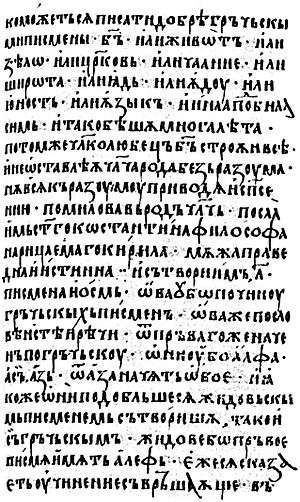Chernorizets Hrabar
Chernorizets Hrabar (Church Slavonic: Чрьнори́зьць Хра́бръ, Črĭnorizĭcĭ Hrabrŭ, Bulgarian: Черноризец Храбър)[note 1] was a Bulgarian[1] monk, scholar and writer who worked at the Preslav Literary School at the end of the 9th and the beginning of the 10th century.[2]
Name
His appellation is correctly translated as "Hrabar, the Black Robe Wearer" (i.e., Hrabar The Monk), chernorizets being the lowest rank in the monastic hierarchy (translatable as black robe wearer, see wikt:Reconstruction:Proto-Slavic/čьrnъ and wikt:riza), "Hrabar" ("Hrabr") supposed to be his given name. However, sometimes he is referred to as "Chernorizets the Brave", "Brave" being the translation of "Hrabar" assumed to be a nickname.
No biographical information is available about him, but his name is usually considered to be a pseudonym used by one of the other famous men of letters at the Preslav Literary School or may be even by Tsar Simeon I of Bulgaria (893-927), since normally monks assume Christian names of biblical or early Christian onomastics.
On the Letters

Chernorizets Hrabar is (as far as is known) the author of only one literary work, "On the Letters" (Church Slavonic: О писмєньхъ, O pismenĭhŭ, Bulgarian: За буквите), one of the most admired and popular works of literature written in Old Church Slavonic. The work was supposedly written some time after the Preslav Ecclesiastical People's Council in 893, but before 921,[3] and is the only known medieval literary work to quote the exact year of the invention of the Glagolitic alphabet (855). The work was partly based on Greek scholia and grammar treatises and expounded on the origin of the Glagolitic alphabet and Slavic Bible translation.[3]
In On the Letters, Chernorizets Hrabar defends the alphabet against its Greek critics and proves not only its right to existence but also its superiority to the Greek alphabet arguing that the Greek letters are neither the oldest known to man, nor divine. At the same time Chernorizets Hrabar opposes Glagolitic dogmatists and makes several suggestions as to how the alphabet can be further improved.
He also provided information critical to Slavonic palaeography with his mention that the pre-Christian Slavs employed "strokes and incisions" (Church Slavonic: чръты и рѣзы, črŭty i rězy), translated as "tallies and sketches" below) writing that was, apparently, insufficient properly to reflect the spoken language. It is thought that this may have been a form of runic script but no authentic examples are known to have survived.
Textual criticism
The manuscript of On the Letters has been preserved in 79 copies in seven families of texts, including five contaminated manuscripts, plus four abridgements independent of the seven families.[3] All of these families probably ultimately share a common protograph.[3] Not one of the textual families contains an optimal text, and none of them can be established to be the source of any other.[3] None of the text families can be shown to have dialectal features, albeit some of the individual manuscripts in the families do have them.[3] The protograph was written in Glagolitic, and it underwent significant change or corruption in the course of its successive transcription into seven families of Cyrillic texts.[3] Today only Cyrillic manuscripts survive.[3] The hyparchetypes of all seven families give the number of the letters in the alphabet as 38, but the original Glagolitic alphabet had only 36, as attested in the acrostic of Constantine of Preslav; however, one of the abridgements instead gives the number as 37 and another gives it as 42.[3]
The oldest surviving manuscript copy dates back to 1348 and was made by the monk Laurentius for Tsar Ivan Alexander of Bulgaria. The work has also been printed in Vilnius (1575–1580), Moscow (1637), Saint Petersburg (1776), Supraśl (1781).
Excerpt
Прѣжде ѹбо словѣне не имѣхѫ писменъ · нѫ чрътами и рѣзами чьтѣхѫ и гатаахѫ погани сѫще · кръстивше же сѧ · римьсками и гръчьскыми писмены · нѫждаахѫ сѧ словѣнскы рѣчь безъ устроениа… Потомже чл҃колюбецъ б҃ъ… посла имь ст҃го Кѡнстантина философа · нарицаемаго Кирила · мѫжа праведна и истинна · и сътвори имъ · л҃ писмена и осмь · ѡва убѡ по чинѹ Гръчьскъıхь писменъ · ѡва же по словѣнъстѣи рѣчи
- Being still pagans, the Slavs did not have their own letters, but read and communicated by means of tallies and sketches.[note 2] After their baptism they were forced to use Roman and Greek letters in the transcription of their Slavic words but these were not suitable ...[note 3] At last, God, in his love for mankind, sent them St. Constantine the Philosopher, called Cyril, a learned and upright man, who composed for them thirty-eight letters, some (24 of them) similar to the Greek, but some (14 of them) different, suitable to express Slavic sounds.
Legacy
Hrabar Nunatak on Greenwich Island in the South Shetland Islands, Antarctica is named for Chernorizets Hrabar.
See also
Footnotes
- Sometimes modernized as Chernorizetz Hrabar, Chernorizets Hrabr or Crnorizec Hrabar
- Note: "by means of tallies and sketches" - the original "чрътами и рѣзами" is literally translated as "by means of drawn and cut drawings", i.e., "by means of strokes and incisions"
- In this place are listed eleven examples of Slavic words, such as "живѣтъ" /živětŭ/ "life", which can be hardly written using the unadapted Roman or Greek letters (i.e. without diacritic changing their sound-values).
Notes
- A history of East Central Europe: East Central Europe in the Middle Ages, 1000-1500, Jean W. Sedlar, University of Washington Press, 1994, p. 430., ISBN 0-295-97290-4
- A concise history of Bulgaria, R. J. Crampton, Cambridge University Press, 2005,pp. 16-17., ISBN 0-521-61637-9
- William Veder (1996), Textual Incompatibility and Many-Pronged Stemmata.